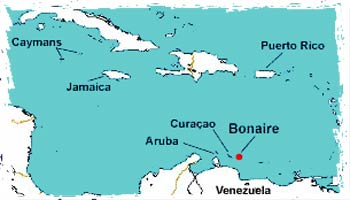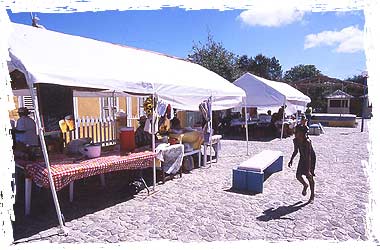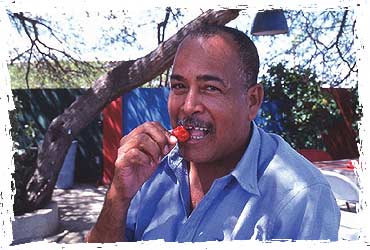As I arrived at the Flamingo Airport on the southern Caribbean island of Bonaire, I received some bad news. I discovered that I had just missed Karnaval–a seven-day event of colorful parades, excessive libations, and full-tilt boogieing. While the island has only 15,000 residents, a local informed me that pound for pound, this celebration could compete any day against a New Orleans’ Mardi Gras.
|
|
The island of Bonaire,
|
The good news was that because of Karnaval, the usual first-Saturday-of-the-month food market at Rincón, Bonaire’s oldest town, had been postponed for a week. And yes, I would now have a chance to witness it. So I packed up my rental car with some local music and headed over the hill to the inland village.
|
|
Rincon market
|
The drive to Rincón winds through the parched, cactus-filled landscape that is signature of this former Dutch colony. The land has the look of southern Arizona, but the roadside homes reminded me of Holland farmhouses gone psychedelic. Many retain the classic gables and orange-tiled roofs reminiscent of the Lowlands. The walls, however, are painted brilliant pink, parrot yellow, or electric green. And just like in the Netherlands, you do not drive far before you are at your destination. In twenty minutes, I had arrived at the old village.
I was told at the Bonaire Tourism Office that Rincón was built inland in a shallow valley some 300 years ago so that marauding pirates could not see the town while sailing by. Indeed, it is surrounded by low, arid hills with no view of the wonderfully blue Caribbean Sea. The town’s first residents were slaves brought in from Africa to work the salt flats on the southern part of the island. While they stayed in crowded huts near the salt works when laboring, the people would return to their upland village whenever they were allowed. Rincón became the vibrant, social center of the island and its rich heritage is still alive today.
Some of that existing culture is culinary, and while the Saturday market only contained six small stalls, the traditional food choices were many. There was kabritu stobá–a goat stew with vegetables. I was offered kabes ku higra–a mix of goat brains and liver, not quite what I had in mind on this hot afternoon. A man there saw me wince at the offer. “What you should really try is sòpi di yuana.”
“What’s that?” I asked, wide-eyed.
“Iguana soup. You know we have wild iguana all over the island. And the males–they have two penises. So if you eat this sopi, the women will love you for it!”
|
|
A candidate for iguana soup?
|
I tasted the soup and it wasn’t bad, but I was surprised to discover that this and all the local dishes lacked any hint of the hot and spicy flavor which I so crave. I strolled down to the last stall where fresh produce was sold. Surely, I would find a habanero or two there. I saw yuca–a fibrous root which I have enjoyed before on other island expeditions. There was large, leafy spinach from neighboring Curaçao. I also spotted some very large papayas. I chose one that had the promise of sweet, tropical bliss. “Is this all for you today?” asked Swinda Trinidad, the friendly vendor.
“Actually, if you have any peppers I would like to buy them too.” Thoughts of a sweet/spicy, papaya/pepper concoction filled my head. My saliva glands began to respond only to be suddenly halted.
“The only pepper I have are these bell peppers,” said Swinda. “People around here don’t really care for spicy food too much.”
It turned out that Swinda fully lives up to her last name since she hails from the island of Trinidad. We talked dreamily of Matouk’s, a famous Trinidadian hot sauce, and other fiery delights from her country of origin. As I finally began to walk away, Swinda bid farewell. “When you go back to Kralendijk, you might want to ask around about pika. Goodbye.” She waved and turned to her next customer before I could reply. Hmmmm, pika. That sounded promising. In a flash, I was off to Bonaire’s busy capital and seaside port.
I ended up at water’s edge having a cold one at Karel’s Beach Bar. It’s a wonderful watering hole that juts out into the harbor where tourists drink too much and sing off-key karaoke. What other kind is there? While finishing my cold beer, I noticed an open-air market nearby and asked the bartender about it. “Oh, that’s the ‘fish market,’ but they only sell fruits and vegetables there.” That sounded like perfect island logic to me. Perhaps in this market of incongruity I would find out about pika.
Under the protective canvas, I scanned the produce. The only peppers I saw looked a bit like heat-searing Scotch bonnets, but the colors were washed-out green and pale yellow rather than the bold primary hues to which I was accustomed. The vendors here came from nearby Venezuela, only 50 miles south of Bonaire. I asked in Spanish what kind of peppers these were.
“Ají dulce” said the man, a bit perturbed that I had interrupted his tranquil afternoon activity of staring out to the bay.
“Do you know about pika?” I asked.
“That is something of the Bonairians. We don’t eat spicy food in Venezuela. The ají you see here is mostly sweet. Very little heat.” I bid the man goodbye and continued my pursuit of pika, walking the sun-filled streets of Kralendijk.
I had one clue to follow. I was told to look for buildings that said “Aki ta bende kuminda krioyo.” This phrase, roughly translated, means “local food is sold here’ in Papiamento. This is the native language of Bonaire, a linguistic gumbo of Spanish, Dutch, Portuguese, and African dialects. It was in these local eateries that I just might find out about pika. As I approached the outskirts of a town near the neighborhood of Nikiboko, I saw a small restaurant ahead. I didn’t even have to rely on my primitive Papiamento skills to read the writing on the wall. There were two phrases in English: “Local Food” and “Gibi’s Terrace.”
Gibi, whose full name is Gilbert Winklaar, is a gracious Bonairian who invited me inside his restaurant’s courtyard. Finally, I was going to learn about pika.
“Yes, we serve pika here. I make it every day. In Bonaire, we call it pika siboyo because of all the onions we use in it.” He handed me a recycled jar filled with vinegar, onions, and two kinds of pepper.
“There’s a hot pepper in there called Madam Jeanette and the other is Scotch bonnet which has more flavor and is even hotter. I like to mix the two. Pika is used to spice up the Bonairian food. It is like a pepper sauce.”
|
|
Gibi bites into an habanero
|
I looked up to the Amstel Beer menu board. Written in Papiamento was karko (conch), baka stoba (beef stew) and fungi, a corn-based mush used as a side dish. There was also bakijauw, a salt fish dish carried over from the slave days.
Gibi continued. “I make other kinds of pika, too. There’s Jamaican pika which is similar to ours since it’s onion and vinegar-based, but it also has allspice and circular slices of carrots that are shaped like the serrated edge of a gear. That’s real Jamaican. I also make Surinam (formerly Dutch Guiana) pika. That one is more like a paste and it is cooked in oil. You can’t mix the Madame Jeanette and Scotch bonnet in that one because the Scotch bonnet will overpower the other when the peppers are heated.”
I came to learn that Gibi had learned different cuisines as he traveled and worked throughout the region–Costa Rica, Aruba, Venezuela, Curaçao, and Puerto Rico. “I even learned how to cook fast food in New York City,” he laughed. But it seemed to me the place that really made an impact on him was Jamaica.
|
|
Jar of Pika
|
“Come to the kitchen. I will show you how to make a Jamaican jerk the way people do it in the countryside–original style.” Jerk is a thick mixture of peppers, salt, spices and vegetables that is rubbed into meat or fish before it is grilled. It imparts a wonderful, spicy flavor.
“An old man who lived up in the Blue Mountains of Jamaica taught me this one. It has six or seven spices, a lot of Scotch bonnet peppers, onions, and of course salt. Before you cut the peppers, crush them first with the side of your knife. Then you get the most heat,” he said smiling.
As Gibi sliced, cut and blended, the aromas rose from the kitchen counter. It reminded me of my times in Ocho Rios and Montego Bay. “Once everything is blended, you need to rub the jerk thoroughly into the meat. Do this at least a half-day before grilling. Only one or two hours before for fish. Wrap the fish in foil once you apply the jerk. It makes it easier to handle it on the grill and you can catch some of the smoke inside that way.”
“Where do you get your peppers here on Bonaire?” I asked.
“Well, some people here have two or three plants in their yards and I get both Madam Jeannette and Scotch bonnets from them. Otherwise, I rely on Curaçao, the next island over. They also have a Portuguese pepper there. It’s like a jalapeño. Those ají dulce peppers you ran into down at the fish market in Kralendijk are not very hot. The Venezuelans use them with shredded meat.”
As I bid goodbye to Gibi he handed me a large glass jar full of freshly-made Jamaican jerk. “Take that home with you and do some nice cooking. Ajo.”
“Ajo,” I replied. “Goodbye.”
Upon leaving Gibi’s Terrace, I felt I had exhausted the hot and spicy possibilities of Bonaire. But that evening I found myself at the Lighthouse Bar & Restaurant sipping a rum-based Limbo Breeze while owner and chef Wil Heemskerk gave me his take on piquant cuisine.
“Heat wakes up the taste buds and that’s good. But I try not to overpower other food flavors with hot and spicy. It’s better to balance the dish, so that all the tastes contribute.”
This sensibility started years ago when Wil learned French cooking in Belgium, Holland, and France, attaining a coveted two-star Michelin chef rating. He then worked a two-year contract for Chez Lucille on Bonaire and afterwards cooked for a number of years in a New York City Italian restaurant. Later, he and his wife Sue started a “Floribbean” style restaurant in Melbourne, Florida.
But it was always Wil’s dream to return to the lovely island of Bonaire. When an opportunity knocked about a year ago, he and Sue began the Lighthouse Bar & Restaurant just north of Kralendijk.
As I looked out over the Harbor Village Marina, I asked Wil about the challenges of cooking on Bonaire. “You have to be flexible and creative. Our menu reflects the availability of what the fishermen catch and what produce I can buy here or on nearby islands. Here, I made you a few things to taste.”
The session began with paper-thin smoked marlin with a tangy horseradish sauce. A spicy island ceviche followed–raw tuna enhanced with a blend of lime, ginger and sambal oelek, an Indonesian red pepper paste. I finished the meal with grilled mahi mahi topped with a tangy chipotle-mango chutney sauce.
By now a full moon was rising over the water. The island’s trade winds gently moved the palm trees above. With my pursuit of pika concluded, I finished the evening with another Limbo Breeze. Bonaire had treated me well.
|
|
Bonaire sunset Photo by Janice Huckaby
|
Recipes
Gibi learned this recipe many years ago from Carlos, a 73-year-old man who lived in the Blue Mountain region of interior Jamaica. Note that jerk has spread throughout the Caribbean and is not just limited to Jamaica. Use this with pork or chicken. Fifteen Scotch bonnets makes an extremely hot paste, so feel free to lower this amount.
-
10 large scallions, sliced, white part only
-
15 cloves garlic, crushed
-
12 Scotch bonnet peppers, stems removed, crushed first, then sliced
-
1 large onion, sliced
-
3 teaspoons chicken bullion powder
-
1½ teaspoons red Spanish paprika power (smoked pimentón), or substitute chipotle powder
-
½ teaspoon ground cinnamon
-
½ teaspoon ground nutmeg
-
1/4 cup ground allspice
-
Bunch of fresh thyme, chopped
-
3/4 cup salt
Combined all ingredients in a food processor and process until a thick paste consistency is achieved. Rub the jerk into meat a half day before grilling. For fish, the rub can be applied only a few hours before.
Yield: About 2½ cups
Heat Scale: Extremely hot
Serve this condiment over any grilled fish or poultry. A combination of Scotch bonnet and Madame Jeanette chiles are used in Bonaire, but any variety of habanero can be used.
-
1 large white onion, sliced
-
4 habanero-type chiles, seeds and stems removed, minced
-
2 cups distilled vinegar
-
Pinch of salt
Combine all the ingredients in a jar. Let stand for about 2 to 3 hours.
Yield: About 3 cups
Heat Scale: Hot
Here is the version of pika from former Dutch Guiana. If you were in Bonaire, you would use either Scotch bonnets or the much milder Madame Jeanette. The Scotch bonnets will overpower the flavor of the other when cooked if you use both. I have adapted this for American kitchens.
-
½ cup vegetable oil
-
15 yellow wax hot chiles, seeds and stems removed, chopped
-
1 habanero chile, seeds and stems removed, chopped
-
½ large white onion, sliced
-
1 clove garlic, minced
-
1 teaspoon brown sugar
-
Salt to taste
Heat the oil in a pan and add the chiles, onion, and garlic. Cook, uncovered, over very low heat for a half hour, stirring frequently. Add the sugar and salt, stirring well, and simmer until mixture is of a paste consistency. Add a little water if too thick.
Yield: About 2 cups
Heat Scale: Hot
Note the presence of allspice in this Jamaican version of the pika condiment. Serve over any grilled or roasted meat, fish, or poultry.
-
1 large white onion, sliced
-
2 Scotch bonnet peppers (or substitute habanero), seeds and stems removed, minced
-
1 teaspoon ground allspice
-
1 carrot, sliced in circles, edges cut to resemble that of a gear
-
1½ cups distilled vinegar
-
½ cup water
-
1 clove garlic, minced
-
Pinch of salt
Combine all the ingredients in a jar or bowl. Let stand for 2 hours.
Yield: About 3 cups
Heat Scale: Hot
Here is chef Wil Heemskerk’s take on ceviche, the dish that uses citric acid to “cook” the fish. Virtually any fish can be used in this dish, but Wil prefers strongly flavored fish like tuna or kingfish. Serve this as a fancy appetizer.
-
1½ teaspoons sambal oelek (Asian chile paste)
-
3 teaspoons chopped fresh ginger
-
3 tablespoons Asian fish sauce (nam pla)
-
½ cup freshly squeezed lime juice
-
1 14-ounce can unsweetened coconut milk
-
3 tablespoons unsweetened grated coconut
-
1 tablespoon cilantro, chopped
-
1 tablespoon chopped Italian parsley
-
2 tablespoons chopped scallions
-
1½ pounds tuna, cut in 1/4-inch cubes
-
Bag of baby lettuce
-
8 cilantro sprigs for garnish
In a bowl, combine all ingredients except the tuna, lettuce, and cilantro sprigs. Add the tuna and combine very gently–do this step right before you are ready to serve. Marinate the tuna for no more than15 minutes–do not over marinate!
To serve, chill 8 martini glasses. Place baby lettuce in each glass up to the rim. Add a scoop of ceviche and garnish with a cilantro sprig.
Yield: 8 servings
Heat Scale: Mild










